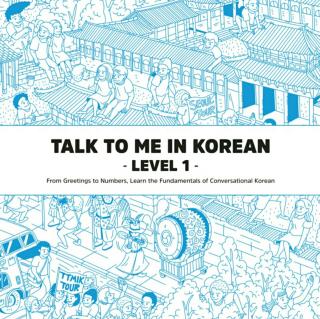
介绍:
TalkToMeInKorean.com - Free Korean Lesson Notes
LEVEL 1 LESSON 5
This PDF is to be used along with the MP3 audio lesson available at TalkToMeInKorean.com.
Please feel free to share TalkToMeInKorean’s free Korean lessons and PDF files with anybody who
is studying Korean. If you have any questions or feedback, visit TalkToMeInKorean.com.
After studying with this lesson, you will be able to say things like “A is B(noun).” or “I am
ABC(noun).” in polite/formal Korean.
이에요 / 예요 [i-e-yo / ye-yo]
이에요 and 예요 have a similar role to that of the English verb “to be”. The fundamental
difference, however, is the sentence structure that they are used in.
English sentence structure:
ABC + [be] + DEF.
** DEF is a noun here.
Ex)
ABC is DEF.
I am ABC.
You are XYZ.
Korean sentence structure:
ABC + DEF + [be]
** DEF is a noun here.
Ex)
이거 ABC예요. [i-geo ABC-ye-yo] = This is ABC.
In English, the verb “to be” is changed to “am” “are” or “is” depending on the subject of the
sentence, but in Korean, you decide whether to use 이에요 [i-e-yo] or 예요 [ye-yo] depending
on whether the last letter in the previous word ended in a consonant or a vowel.
이에요 and 예
요 are very similar and also sound similar so it is not such a big problem if you mix up these
two, but it is better to know the correct forms.
When you want to say that ABC “is” DEF in Korean, if the word for “DEF” has a final consonant
in the last letter, you add 이에요 [i-e-yo], but if it doesn’t have a final consonant and ends in
a vowel, you add 예요 [ye-yo]. This is just to make the pronounciation of the connected part
easier,so it will come naturally if you practice with some sample sentences.
Final consonant + 이에요 [i-e-yo]
No final consonant (Only vowel) + 예요 [ye-yo]
Sample sentences:
물이에요. = 물 + 이에요 [mul + i-e-yo]
(It’s) water.
가방이에요. = 가방 + 이에요 [ga-bang + i-e-yo]
(It’s) a bag.
사무실이에요. = 사무실 + 이에요 [sa-mu-sil + i-e-yo]
(It’s) an office.
학교예요. = 학교 + 예요 [hak-gyo + ye-yo]
(It’s) a school.
저예요. = 저 + 예요 [jeo + ye-yo]
(It’s) me.
As you can see from the examples above, in Korean, you don’t have to use articles like “a/an”
or “the” as in English. So when you look up a noun in your Korean dictionary, you can add 이에
요 or 예요 and then it means “It is ABC.” “That is DEF.” “I am XYZ.”
You can also make this a question simply by raising the tone at the end of the sentence.
물이에요. [mul-i-e-yo] = It’s water.
물이에요? [mul-i-e-yo?] = Is that water? Is this water?
학교예요. [hak-gyo-ye-yo] = It’s a school.
학교예요? [hak-yo-ye-yo] = Is it a school? Are you at school now?
뭐 [mwo] = what
뭐예요? [mwo-ye-yo?] = What is it? What’s that?
-END-

